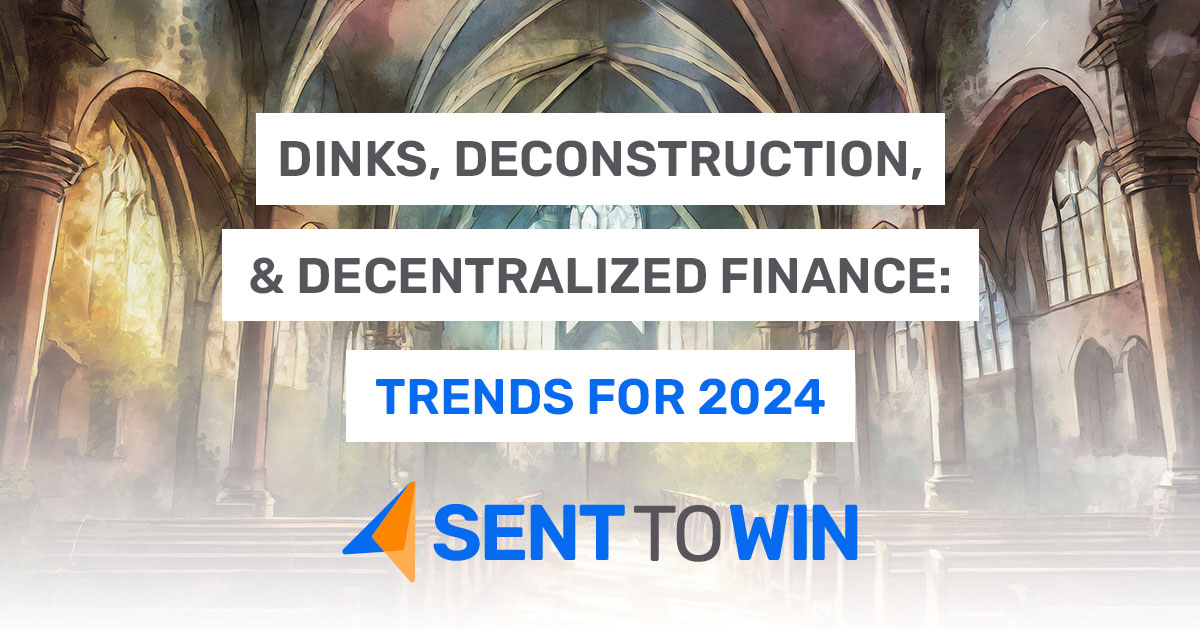DINKS, Deconstruction, and Decentralized Finance: Trends for 2024
From time to time, it is important for us to take a step back and get a good sense of the big picture – the macroeconomic trends and forces of culture that will end up trickling down and affecting our businesses and ministries. As 2023 winds to a close, we’d like to examine 3 big ideas that show signs of significant impact on our respective bottom lines in 2024 and beyond.
DINKs – The slow movement towards an aging population, niche youth culture, and small-scale consumerism
The United States’ fertility rate dropped to an all-time low in 2020 (1.64 births/woman), and though it has technically increased (1.67 births/woman) since then, the larger trend does seem to indicate further stagnation or perhaps even decline. With the replacement rate sitting at 2.1 births/woman, we find ourselves in a situation where the population is going to continue getting older in 2024, and possibly beyond. With a median age of 38.9, and 10,000 individuals hitting retirement age each year, we are on our way to a situation where most Boomers will be retired by 2030 – and eligible for Social Security and Medicare.
That puts a large strain on the US economy, which already dedicates about 5% of GDP and nearly half of the entire federal budget to Social Security and Medicaid. In 2024 and continuing forward, the solvency issues of these programs (and the resulting pressure on the economy) is going to increase.
So what does this mean?
The American Dream of a house in the suburbs with a white picket fence, a dog, and 2.5 children seems unattainable for many young people, and more attainable goals seem to be taking its place. Travel, Pet care, and the DINK (Dual-Income, No Kids) lifestyle are on the rise on social media, as Millennials and Gen Z increasingly report doubts about whether they will ever be able to afford a home or afford to raise children. Instead, conspicuous consumption, vacations, and other “luxuries” are consolation prizes as people try to make the best of the situation.
Whether DINKs are part of the reason for the economy and demographic shift we find ourselves in or a result of it, their popularity online is a conspicuous element of modern society: Young people are marrying later and later, putting off having children or choosing not to have children at all. Values have continued shifting away from traditional ideals of family legacy to comfort, consumption, personal expression, and unique experiences.
Even the Christian community, which is supposed to hold “Be fruitful and multiply” as one of the most fundamental commands given by God to men, barely outpaces their secular counterparts. Christians in this country have a fertility rate of around 1.9 – still well below the replacement rate, and all things considered, not much better than the 1.6 of their religiously unaffiliated counterparts.
Three takeaways:
- The healthcare industry will continue to grow, due to the aging population.
- Youth culture will become further disconnected from the mainstream, targeting isolated, niche groups according to interests, and it will emphasize conspicuous consumption.
- The real estate market is going to be a rollercoaster ride for the next several years, due to demographic, fiscal, and market forces.
Deconstruction – The steep decline in religious observance, affiliation, and a heavy increase in suspicion and institutional distrust.
According to extensive research by Pew, religion in America continues its unprecedented decline. In 1972, 90% of the population identified as Christian, but today, that number is just 63%, with only about 50% of Americans in their 20s claiming Christianity as their faith.
The past few years have seen many highly visible defections from the faith, and the idea of “deconstruction” gained a lot of steam. Deconstruction does not necessarily mean apostasy, however, as many groups within the church have spoken out against practices and attitudes within modern, American Christianity that need to be corrected in order to align with the Bible’s teaching. For many, reconstruction is going to eventually follow deconstruction, as people arrive at some conclusions after mulling over their questions. Late in 2023, we have even seen some high-profile prodigals, such as the former CCM artist Michael Gungor report that he is actively searching for a church to join.
Evangelicalism tends to grab the headlines, with terms such as “Exvangelical” and “Ex-fundy” framing the discussion, but among former Christians, almost 4 in 10 reports having left Catholicism, and nearly a quarter came from non-evangelical circles. White, evangelical protestant was the background of only 13% of the individuals surveyed who had recently left their faith. Additionally, Americans have been changing denominations at a higher rate than usual.
Over time, this could mean an overall decrease in religious observance in America, but it will likely also mean a radical change or shift in how people who retain their faith worship. It is, perhaps, a related phenomenon that while religious faith declines, so too does faith in our institutions in general.
Americans are changing how they see themselves, increasingly less as “Christian,” and even for Christians, many are on a journey of deciding what aspects of modern, Western Christianity are and are not core to the faith – and to them, personally.
Three takeaways:
- Traditional demographics of market segmentation may be obsolete. “35 years old, Christian, male,” for example, may not be a reliable indicator of a person’s views and goals in 2024.
- Currently churchless believers will look for community and a way of worship that they resonate with.
- The “old” institutions (Record labels, Christian bookstores, and other cultural organizations stemming from the Jesus Movement era, as well as many mainline protestant institutions) will recede, and newer movements will vie for prominence to replace them.
Decentralized Finance – The constriction of traditional lending, the rise of institutionalized crypto trading, AI solutions, and alternative capital-raising.
An inflated U.S. dollar, conflict in Europe and the Middle East, supply chain issues, and the constant possibility of cyberattacks lead us into 2024 with a sense of global instability. This “polycrisis” even involved indications of deglobalization, according to some experts, and the result is that business as usual will continue its leisurely stroll out the door next year.
One of the effects of these troubles is greater institutional interest in cryptocurrency and its promise of decentralized financial substructure. Bitcoin and Ethereum are likely to increase in value in 2024, and most likely significantly increase, if and when Blackrock’s (and Grayscale’s?) Bitcoin Spot ETFs are approved. That expectation has already led to a rise in BTC and ETH valuation, which has proven resilient in the wake of SBF’s and CZ’s respective convictions.
As the market uncertainty continues alongside the rise in cryptocurrency, we will see an increase in dubious market offerings and ICMs for new tokens based on the Ethereum blockchain, so buyers beware. More money flowing into crypto could bring increased scrutiny, and big projects, such as Tether (the dominant stablecoin) could end up in hot water if the market reacts. Investors should pay close attention to movement in the crypto space because the rewards are great, but so are the risks.
Banks have already greatly tightened lending, and though that could ease up some if the Fed decides to reduce interest rates, there is a general shift away from traditional loans by large, commercial banks, such as new business loans and mortgages. New businesses, and existing businesses that want to expand, will have to find new and creative ways of raising capital, as well as leveraging existing methods, such as crowdfunding, angel investors, and venture capital.
The side-gig economy isn’t showing any signs of slowing down, so platforms that empower individuals (Printify, KDP, Shopify, etc.) will do well, but we will also have to endure a rise in MLMs, questionable affiliate marketing training courses, and fake gurus. Thank God for Coffeezilla. Also, thanks to AI business tools, which act as a force multiplier to an individual entrepreneur, we could see an overall reduction in the size of most small businesses – and a proliferation of small businesses that don’t need to raise capital in order to get off the ground and run. Barriers to entry are lowering, on the one hand, and rising on the other.
In other words? Finance in 2024 isn’t quite going to be the Wild West – but it isn’t going to be a pleasant trip down the river either. It’s likely to be a dynamic time, so stay on your toes.
Three takeaways:
- Beware of scams in 2024, as people will be more willing to overlook red flags in the hopes of catching a financial break.
- Get creative when looking for capital.
- Consider investing in the mainstays of the Crypto space, but don’t put all your eggs in the digital basket.
Quick Hits
- Google agrees to pay a $700 million settlement and make changes to its Google Play app store.
- Existing home sales fell to a 13-year low recently, sending ripples through related industries.
- At Pope Francis’ direction, the Catholic Church may now bless same-sex unions, in a move that has angered conservative Catholics and many Protestants.
- A new study demonstrates that Tesla has the highest rate of accidents of any car brand.
- The VR market continues to shrink, even as Meta injects billions.
For Kingdom Leaders, By Kingdom Leaders
Bringing Kingdom-minded leaders like you fresh perspectives and insights on business, finance, and leadership trends.




